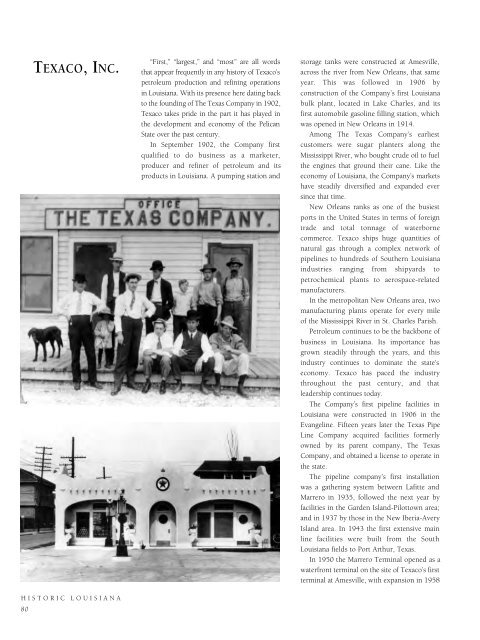Historic Louisiana
An illustrated history of Louisiana, paired with the histories of companies, families and organizations that make the state great.
An illustrated history of Louisiana, paired with the histories of companies, families and organizations that make the state great.
Create successful ePaper yourself
Turn your PDF publications into a flip-book with our unique Google optimized e-Paper software.
HISTORIC LOUISIANA<br />
80<br />
TEXACO, INC.<br />
“First,” “largest,” and “most” are all words<br />
that appear frequently in any history of Texaco’s<br />
petroleum production and refining operations<br />
in <strong>Louisiana</strong>. With its presence here dating back<br />
to the founding of The Texas Company in 1902,<br />
Texaco takes pride in the part it has played in<br />
the development and economy of the Pelican<br />
State over the past century.<br />
In September 1902, the Company first<br />
qualified to do business as a marketer,<br />
producer and refiner of petroleum and its<br />
products in <strong>Louisiana</strong>. A pumping station and<br />
storage tanks were constructed at Amesville,<br />
across the river from New Orleans, that same<br />
year. This was followed in 1906 by<br />
construction of the Company’s first <strong>Louisiana</strong><br />
bulk plant, located in Lake Charles, and its<br />
first automobile gasoline filling station, which<br />
was opened in New Orleans in 1914.<br />
Among The Texas Company’s earliest<br />
customers were sugar planters along the<br />
Mississippi River, who bought crude oil to fuel<br />
the engines that ground their cane. Like the<br />
economy of <strong>Louisiana</strong>, the Company’s markets<br />
have steadily diversified and expanded ever<br />
since that time.<br />
New Orleans ranks as one of the busiest<br />
ports in the United States in terms of foreign<br />
trade and total tonnage of waterborne<br />
commerce. Texaco ships huge quantities of<br />
natural gas through a complex network of<br />
pipelines to hundreds of Southern <strong>Louisiana</strong><br />
industries ranging from shipyards to<br />
petrochemical plants to aerospace-related<br />
manufacturers.<br />
In the metropolitan New Orleans area, two<br />
manufacturing plants operate for every mile<br />
of the Mississippi River in St. Charles Parish.<br />
Petroleum continues to be the backbone of<br />
business in <strong>Louisiana</strong>. Its importance has<br />
grown steadily through the years, and this<br />
industry continues to dominate the state’s<br />
economy. Texaco has paced the industry<br />
throughout the past century, and that<br />
leadership continues today.<br />
The Company’s first pipeline facilities in<br />
<strong>Louisiana</strong> were constructed in 1906 in the<br />
Evangeline. Fifteen years later the Texas Pipe<br />
Line Company acquired facilities formerly<br />
owned by its parent company, The Texas<br />
Company, and obtained a license to operate in<br />
the state.<br />
The pipeline company’s first installation<br />
was a gathering system between Lafitte and<br />
Marrero in 1935, followed the next year by<br />
facilities in the Garden Island-Pilottown area;<br />
and in 1937 by those in the New Iberia-Avery<br />
Island area. In 1943 the first extensive main<br />
line facilities were built from the South<br />
<strong>Louisiana</strong> fields to Port Arthur, Texas.<br />
In 1950 the Marrero Terminal opened as a<br />
waterfront terminal on the site of Texaco’s first<br />
terminal at Amesville, with expansion in 1958
















